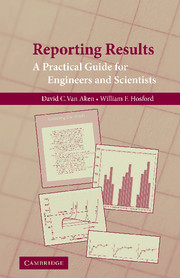Book contents
- Frontmatter
- Contents
- Preface
- REPORTING RESULTS
- 1 Elements of Technical Writing
- 2 Technical Papers
- 3 Technical Letters
- 4 Oral Presentations
- 5 Presentation of Technical Data
- 6 Statistical Analysis of Experimental Data
- 7 Resumé Writing
- Appendix I COMMON ERRORS IN WRITING
- Appendix II PUNCTUATION
- Appendix III COMMON WORD ERRORS
- Appendix IV INTERNATIONAL SYSTEM OF PREFIXES AND UNITS
- Appendix V THE GREEK ALPHABET AND TYPICAL USES
- Appendix VI STRAIGHT-LINE PLOTS FOR SOME MATHEMATICAL FUNCTIONS
- References
- Index
1 - Elements of Technical Writing
Published online by Cambridge University Press: 05 September 2012
- Frontmatter
- Contents
- Preface
- REPORTING RESULTS
- 1 Elements of Technical Writing
- 2 Technical Papers
- 3 Technical Letters
- 4 Oral Presentations
- 5 Presentation of Technical Data
- 6 Statistical Analysis of Experimental Data
- 7 Resumé Writing
- Appendix I COMMON ERRORS IN WRITING
- Appendix II PUNCTUATION
- Appendix III COMMON WORD ERRORS
- Appendix IV INTERNATIONAL SYSTEM OF PREFIXES AND UNITS
- Appendix V THE GREEK ALPHABET AND TYPICAL USES
- Appendix VI STRAIGHT-LINE PLOTS FOR SOME MATHEMATICAL FUNCTIONS
- References
- Index
Summary
The ability to communicate clearly is the most important skill engineers and scientists can have. Their best work will be lost if it is not communicated effectively. In this chapter, elements of the technical style of writing are examined. Technical writing differs in presentation and tone from other styles of writing; these differences are described first. The most important elements of the technical writing style to be discussed are conciseness and unambiguity. The chapter ends with a discussion of proofreading and some helpful hints in developing technical writing skills.
Presentation and Tone
Technical communication differs from fiction in many ways. In mystery novels the reader is kept in suspense because the writer has hidden important clues that are explained at the end of the story to produce a surprise. In contrast, the readers of technical writing are given the important conclusions at the beginning, followed by evidence supporting those conclusions. The following example illustrates the difference. The simple question Do we have any mail today? can be answered by a man sitting on his porch in two ways.
He could say: “I got up out of my chair and sauntered out to the mailbox. I looked up before opening the box and saw the mailman going down the street past our house. When I opened the mailbox there was nothing in it, so I don't think we'll have any mail today.”
- Type
- Chapter
- Information
- Reporting ResultsA Practical Guide for Engineers and Scientists, pp. 1 - 12Publisher: Cambridge University PressPrint publication year: 2008



